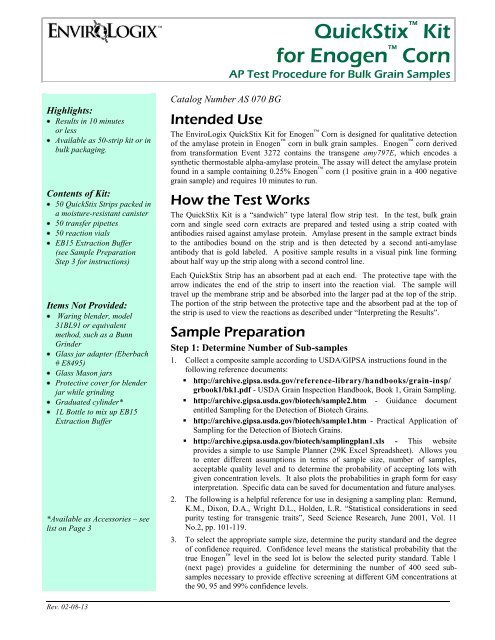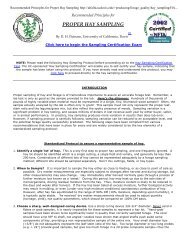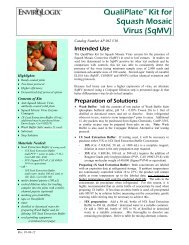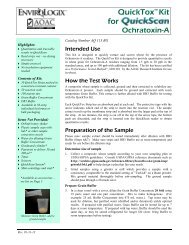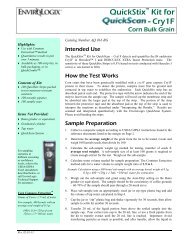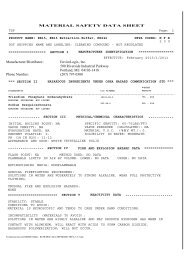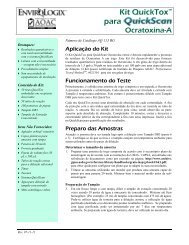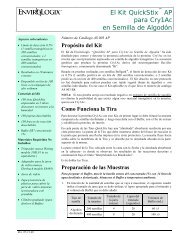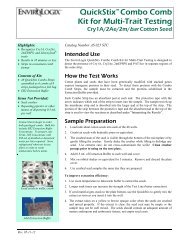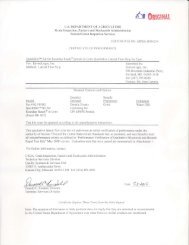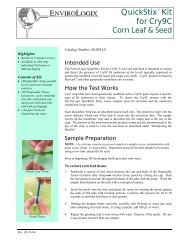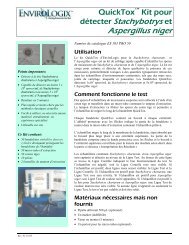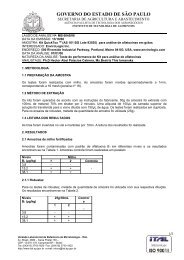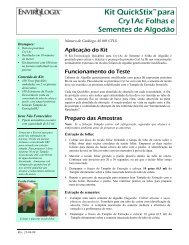QuickStix™ Kit for Enogen™ Corn - EnviroLogix
QuickStix™ Kit for Enogen™ Corn - EnviroLogix
QuickStix™ Kit for Enogen™ Corn - EnviroLogix
Create successful ePaper yourself
Turn your PDF publications into a flip-book with our unique Google optimized e-Paper software.
Highlights:<br />
Results in 10 minutes<br />
or less<br />
Available as 50-strip kit or in<br />
bulk packaging.<br />
Contents of <strong>Kit</strong>:<br />
50 QuickStix Strips packed in<br />
a moisture-resistant canister<br />
50 transfer pipettes<br />
50 reaction vials<br />
EB15 Extraction Buffer<br />
(see Sample Preparation<br />
Step 3 <strong>for</strong> instructions)<br />
Items Not Provided:<br />
Waring blender, model<br />
31BL91 or equivalent<br />
method, such as a Bunn<br />
Grinder<br />
Glass jar adapter (Eberbach<br />
# E8495)<br />
Glass Mason jars<br />
Protective cover <strong>for</strong> blender<br />
jar while grinding<br />
Graduated cylinder*<br />
1L Bottle to mix up EB15<br />
Extraction Buffer<br />
*Available as Accessories – see<br />
list on Page 3<br />
Rev. 02-08-13<br />
Catalog Number AS 070 BG<br />
QuickStix <strong>Kit</strong><br />
<strong>for</strong> Enogen <strong>Corn</strong><br />
AP Test Procedure <strong>for</strong> Bulk Grain Samples<br />
Intended Use<br />
The <strong>EnviroLogix</strong> QuickStix <strong>Kit</strong> <strong>for</strong> Enogen <strong>Corn</strong> is designed <strong>for</strong> qualitative detection<br />
of the amylase protein in Enogen corn in bulk grain samples. Enogen corn derived<br />
from trans<strong>for</strong>mation Event 3272 contains the transgene amy797E, which encodes a<br />
synthetic thermostable alpha-amylase protein. The assay will detect the amylase protein<br />
found in a sample containing 0.25% Enogen corn (1 positive grain in a 400 negative<br />
grain sample) and requires 10 minutes to run.<br />
How the Test Works<br />
The QuickStix <strong>Kit</strong> is a “sandwich” type lateral flow strip test. In the test, bulk grain<br />
corn and single seed corn extracts are prepared and tested using a strip coated with<br />
antibodies raised against amylase protein. Amylase present in the sample extract binds<br />
to the antibodies bound on the strip and is then detected by a second anti-amylase<br />
antibody that is gold labeled. A positive sample results in a visual pink line <strong>for</strong>ming<br />
about half way up the strip along with a second control line.<br />
Each QuickStix Strip has an absorbent pad at each end. The protective tape with the<br />
arrow indicates the end of the strip to insert into the reaction vial. The sample will<br />
travel up the membrane strip and be absorbed into the larger pad at the top of the strip.<br />
The portion of the strip between the protective tape and the absorbent pad at the top of<br />
the strip is used to view the reactions as described under “Interpreting the Results”.<br />
Sample Preparation<br />
Step 1: Determine Number of Sub-samples<br />
1. Collect a composite sample according to USDA/GIPSA instructions found in the<br />
following reference documents:<br />
http://archive.gipsa.usda.gov/reference-library/handbooks/grain-insp/<br />
grbook1/bk1.pdf - USDA Grain Inspection Handbook, Book 1, Grain Sampling.<br />
http://archive.gipsa.usda.gov/biotech/sample2.htm - Guidance document<br />
entitled Sampling <strong>for</strong> the Detection of Biotech Grains.<br />
http://archive.gipsa.usda.gov/biotech/sample1.htm - Practical Application of<br />
Sampling <strong>for</strong> the Detection of Biotech Grains.<br />
http://archive.gipsa.usda.gov/biotech/samplingplan1.xls - This website<br />
provides a simple to use Sample Planner (29K Excel Spreadsheet). Allows you<br />
to enter different assumptions in terms of sample size, number of samples,<br />
acceptable quality level and to determine the probability of accepting lots with<br />
given concentration levels. It also plots the probabilities in graph <strong>for</strong>m <strong>for</strong> easy<br />
interpretation. Specific data can be saved <strong>for</strong> documentation and future analyses.<br />
2. The following is a helpful reference <strong>for</strong> use in designing a sampling plan: Remund,<br />
K.M., Dixon, D.A., Wright D.L., Holden, L.R. “Statistical considerations in seed<br />
purity testing <strong>for</strong> transgenic traits”, Seed Science Research, June 2001, Vol. 11<br />
No.2, pp. 101-119.<br />
3. To select the appropriate sample size, determine the purity standard and the degree<br />
of confidence required. Confidence level means the statistical probability that the<br />
true Enogen level in the seed lot is below the selected purity standard. Table 1<br />
(next page) provides a guideline <strong>for</strong> determining the number of 400 seed subsamples<br />
necessary to provide effective screening at different GM concentrations at<br />
the 90, 95 and 99% confidence levels.
<strong>Corn</strong><br />
Grams of <strong>Corn</strong> x 1.5 =<br />
mL of Extraction Buffer<br />
Avoid pulling up particles when<br />
drawing sample<br />
Rev. 02-08-13<br />
Add extract to vial<br />
Then add strip<br />
*Available as Accessories – see<br />
list on Page 3<br />
Table 1-Amylase<br />
<strong>Corn</strong> Screening<br />
Levels<br />
QuickStix <strong>Kit</strong> <strong>for</strong> Enogen <strong>Corn</strong><br />
Page 2 of 4<br />
Number of 400 kernel subsamples required<br />
<strong>for</strong> screening at specific percentage(s)<br />
of Enogen corn<br />
Confidence Level 1.0% 0.5% 0.1% 0.05%<br />
90% 1 2 6 11<br />
95% 1 2 8 14<br />
99% 2 3 11 21<br />
For other sampling scenarios or different screening or confidence levels, refer to the<br />
USDA/GIPSA Excel spreadsheet described under Step 1 above, or call <strong>EnviroLogix</strong><br />
Technical Support <strong>for</strong> assistance.<br />
Step 2: Determine Average Seed Weight<br />
1. Determine average weight of individual grain to be tested (weigh 100 seeds, divide<br />
by 100). Calculate the weight of the number of grains to be tested (Number of<br />
grains [100] X Average Weight/Grain). Use this weight <strong>for</strong> easy measuring of<br />
multiple subsamples into respective jars in preparation <strong>for</strong> grinding.<br />
Step 3: Prepare the Sample<br />
Prepare EB15 Extraction Buffer –Pour the entire contents of the supplied buffer packet into 1<br />
liter of tap water. Thoroughly mix to dissolve the buffer. Store at room temperature when not in<br />
use. (See Precautions and Notes; MSDS available at www.envirologix.com/KR242MSDS.pdf).<br />
1. Weigh seed sample into a 16-ounce glass Mason jar <strong>for</strong> grinding. (If subsampling<br />
from a larger ground sample, weigh sample into a cup with a cap*.)<br />
2. Put protective cover over the jar attached to the blender.<br />
3. Grind sample with a Waring blender (or equivalent method) and jar adapter on high<br />
speed <strong>for</strong> a grinding time of 20-30 seconds or until all whole grains are broken.<br />
4. Add the volume of Extraction Buffer calculated by the <strong>for</strong>mula at left. For<br />
example: If testing 400 kernels with an average weight of 0.25g: (400 x 0.25) =<br />
100g x 1.5 = 150 mL Extraction Buffer.<br />
5. Cap the jar and shake vigorously <strong>for</strong> at least 30 seconds, or longer if needed, to<br />
thoroughly wet all of the corn in the sample. Sample will begin to settle<br />
immediately and liquid can be drawn off at that time.<br />
6. Draw up enough liquid extract from above the settled sample to fill the long narrow<br />
tip of the transfer pipette up to the line at the top of the flared portion of the pipette<br />
bulb (see illustration on left sidebar). Avoid pulling up particles. Dispense extract<br />
(0.5 mL) into reaction vial.<br />
7. To prevent cross-contamination, thoroughly clean blender parts and jars to remove<br />
dust and residue prior to preparation of a second sample. Use a new transfer pipette<br />
and reaction vial <strong>for</strong> each sample.<br />
How to Run the QuickStix Strip Test<br />
1. Allow refrigerated canisters to come to room temperature be<strong>for</strong>e opening. Remove<br />
the QuickStix Strips to be used. Avoid bending the strips. Reseal the canister<br />
immediately.<br />
2. Place the strip into the reaction vial. The sample will travel up the strip. Reaction<br />
vials will stand on their own or may be inserted into the cardboard racks provided.<br />
3. Allow the strip to develop <strong>for</strong> 10 minutes be<strong>for</strong>e making final assay interpretations.<br />
Positive sample results may become obvious much more quickly.<br />
4. To retain the strip, cut off and discard the bottom section of the strip covered by the<br />
arrow tape.<br />
NOTE: Use extreme caution to prevent sample-to-sample cross-contamination<br />
with grain, fluids, or disposables.
Wait 10 minutes; read results<br />
Any clearly discernable pink Test<br />
Line is considered positive<br />
Rev. 02-08-13<br />
Interpreting the Results<br />
Development of the Control Line within 10 minutes<br />
indicates that the strip has functioned properly. Any strip<br />
that does not develop a Control Line should be discarded,<br />
and the sample re-tested using another strip.<br />
If the extract is from a bulk grain sample containing at least<br />
0.25% Enogen corn (Event 3272), a second line (Test<br />
Line) will develop on the membrane strip between the<br />
Control Line and the protective tape. The results should be<br />
interpreted as positive <strong>for</strong> amylase expression.<br />
If the extract is from a negative sample, the strip will only<br />
show the Control Line.<br />
<strong>Kit</strong> Storage<br />
QuickStix <strong>Kit</strong> <strong>for</strong> Enogen <strong>Corn</strong><br />
Page 3 of 4<br />
QuickStix can be stored at room temperature, or refrigerated <strong>for</strong> a longer shelf life.<br />
Note the shelf life on the kit box <strong>for</strong> each storage temperature. The kit may be used in<br />
field applications; however, prolonged exposure to high temperatures may adversely<br />
affect the test results. Do not open the desiccated canister until ready to use the test<br />
strips.<br />
Precautions and Notes<br />
This kit is designed to screen <strong>for</strong> presence or absence only, and is not meant to be<br />
quantitative.<br />
This product is currently not applicable <strong>for</strong> use in any other crop or in leaf tissue<br />
testing.<br />
As with all tests, it is recommended that results be confirmed by an alternate<br />
method if necessary.<br />
The extraction buffer used in the sample preparation procedure is a high pH (>11)<br />
and should be handled using eye and skin protection (safely glasses/goggles and<br />
gloves). MSDS is available at www.envirologix.com/KR242MSDS.pdf. Resulting<br />
corn extract is ~pH 9; check your local regulations concerning disposal.<br />
The assay has been optimized to be used with the protocol provided in the kit.<br />
Deviation from this protocol may invalidate the results of the test.<br />
The results generated through the proper use of this diagnostic tool reflect the<br />
condition of the working sample directly tested. Extrapolation as to the condition<br />
of the originating lot, from which the working sample was derived, should be based<br />
on sound sampling procedures and statistical calculations which address random<br />
sampling effects, non-random seed lot sampling effects and assay system<br />
uncertainty. A negative result obtained when properly testing the working sample<br />
does not necessarily mean the originating lot is entirely negative <strong>for</strong> the analyte or<br />
protein in question.<br />
Warning: a strong positive result may safely be interpreted in as little as 2 minutes<br />
after sample addition. It is not safe to interpret weak positive or negative<br />
results prior to 10 minutes.<br />
DO NOT leave in direct sunlight or in vehicle. Protect all components from hot or<br />
cold extremes of temperature when not in use.<br />
Optional Items Available:<br />
Graduated cylinder (100 mL) ACC 068<br />
Set of 50 sample cups with caps ACC 012
For Technical Support<br />
Contact Us At:<br />
<strong>EnviroLogix</strong><br />
500 Riverside Industrial<br />
Parkway<br />
Portland, ME 04103-1486<br />
USA<br />
Tel: (207) 797-0300<br />
Toll Free: 866-408-4597<br />
Fax: (207) 797-7533<br />
e-mail:<br />
info@envirologix.com<br />
website:<br />
www.envirologix.com<br />
Rev. 02-08-13<br />
QuickStix <strong>Kit</strong> <strong>for</strong> Enogen <strong>Corn</strong><br />
Page 4 of 4<br />
LIMITED WARRANTY<br />
<strong>EnviroLogix</strong> Inc. (“<strong>EnviroLogix</strong>”) warrants the products sold hereunder (“the Products”) against<br />
defects in materials and workmanship when used in accordance with the applicable instructions<br />
<strong>for</strong> a period not to extend beyond a product’s printed expiration date. If the Products do not<br />
con<strong>for</strong>m to this Limited Warranty and the customer notifies <strong>EnviroLogix</strong> in writing of such<br />
defects during the warranty period, including an offer by the customer to return the Products to<br />
<strong>EnviroLogix</strong> <strong>for</strong> evaluation, <strong>EnviroLogix</strong> will repair or replace, at its option, any product or part<br />
thereof that proves defective in materials or workmanship within the warranty period.<br />
ENVIROLOGIX MAKES NO OTHER WARRANTIES, EXPRESS OR IMPLIED,<br />
INCLUDING BUT NOT LIMITED TO ANY IMPLIED WARRANTIES OF<br />
MERCHANTABILITY OR FITNESS FOR A PARTICULAR PURPOSE. The warranty<br />
provided herein and the data, specifications and descriptions of <strong>EnviroLogix</strong> products appearing<br />
in <strong>EnviroLogix</strong> published catalogues and product literature are <strong>EnviroLogix</strong>’ sole representations<br />
concerning the Products and warranty. No other statements or representations, written or oral, by<br />
<strong>EnviroLogix</strong>’ employees, agents or representatives, except written statements signed by a duly<br />
authorized officer of <strong>EnviroLogix</strong> Inc., are authorized; they should not be relied upon by the<br />
customer and are not a part of the contract of sale or of this warranty.<br />
<strong>EnviroLogix</strong> does not warrant against damages or defects arising in shipping or handling, or out<br />
of accident or improper or abnormal use of the Products; against defects in products or<br />
components not manufactured by <strong>EnviroLogix</strong>, or against damages resulting from such non-<br />
<strong>EnviroLogix</strong> made products or components. <strong>EnviroLogix</strong> passes on to customer the warranty it<br />
received (if any) from the maker thereof of such non-<strong>EnviroLogix</strong> made products or components.<br />
This warranty also does not apply to Products to which changes or modifications have been made<br />
or attempted by persons other than pursuant to written authorization by <strong>EnviroLogix</strong>.<br />
THIS WARRANTY IS EXCLUSIVE. The sole and exclusive obligation of <strong>EnviroLogix</strong> shall be<br />
to repair or replace the defective Products in the manner and <strong>for</strong> the period provided above.<br />
<strong>EnviroLogix</strong> shall not have any other obligation with respect to the Products or any part thereof,<br />
whether based on contract, tort, strict liability or otherwise. Under no circumstances, whether<br />
based on this Limited Warranty or otherwise, shall <strong>EnviroLogix</strong> be liable <strong>for</strong> incidental, special,<br />
or consequential damages.<br />
This Limited Warranty states the entire obligation of <strong>EnviroLogix</strong> with respect to the Products. If<br />
any part of this Limited Warranty is determined to be void or illegal, the remainder shall remain<br />
in full <strong>for</strong>ce and effect.<br />
This test kit has been approved by Syngenta <strong>for</strong> detection of the amylase protein in<br />
Enogen corn.<br />
Enogen is a trademark of a Syngenta Group Company<br />
<strong>EnviroLogix</strong>, the <strong>EnviroLogix</strong> logo and QuickStix are trademarks of <strong>EnviroLogix</strong> Inc.<br />
© <strong>EnviroLogix</strong> 2013


